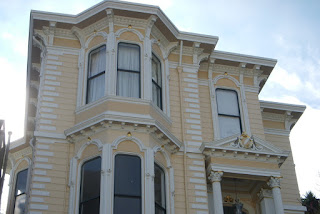 |
| These are instantly recognizable as replacement windows— the fake muntins between the double glazing is a dead giveaway. |
You guessed it—me.
The improvement I’m talking about is window replacement. Some folks do it to reduce maintenance, others to update their home’s appearance. If your main motivation is to reduce your energy bills, however, there are many more cost-effective improvements you could make instead.
 |
| This house has lots of glass, but most don't— the less glass, the less benefit you'll see from upgrading your windows. |
Here's why: In the average house, windows constitute a relatively tiny fraction of the heated envelope—perhaps ten percent or so. This means that, while you may well be doubling the thermal efficiency of the windows, you are only realizing those savings on that ten percent sliver of the heated envelope, rather than on the whole envelope, as you would if you installed a new furnace. Hence, you’ll get far more bang for your buck by increasing attic and duct insulation, or better yet, replacing an obsolete furnace.
 |
| If your existing windows are really junk, you may have a good reason to install high quality replacements such as these. |
And unless your old windows are already white, avoid the tell-tale bright-white frames that are typically seen in replacement work. Instead, choose a color that’ll complement your home’s existing color scheme.
 |
| Whatever you do, make sure that the replacement windows won't detract from the look of your house. Basically, prewar houses have thick window frames, and postwar houses have skinny ones |
In sum, two suggestions: Don't bother replacing your old windows for energy savings alone--you'll never recoup those savings. Put the money into more effective measures first. And if you do have good reasons replace the windows, make sure the new ones will complement your house, not detract from it.


















